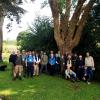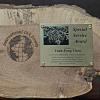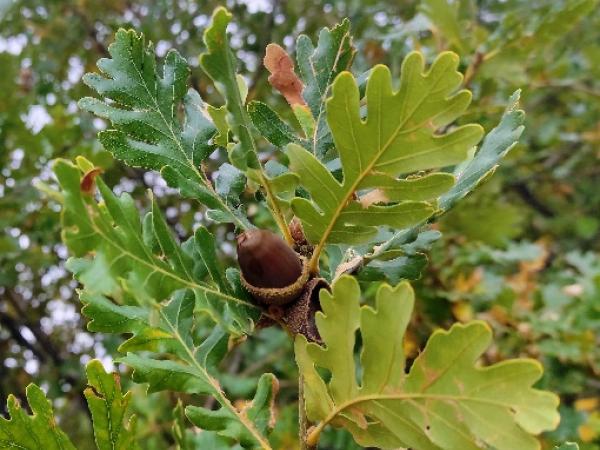Editor's Picks
Plant Focus
Christopher R. Heim, Mark V. Coggeshall, Arpita Konar, and Jeanne Romero-Severson
Published May 2016 International Oaks No. 27: 189–194
Abstract
We have established a northern red oak (Quercus rubra L.) full sib mapping population at the University of Missouri (MU), as part of a multi-year hardwood genomics project sponsored by the National Science Foundation Plant Genome Research Program. New genomic resources derived from this project will enable researchers to identify candidate genes associated with biotic and abiotic stress tolerance. In addition, tools developed by this project will facilitate comparative studies between this species and the pedunculate oak (Q. robur L.), a species for which a full suite of genetic markets has been developed. In 2013 and 2014, we established a total of 1072 grafted ramets of 409 full sib seedlings, plus both parents (mean 2.6 ramets per clone), on an MU-owned research farm. The creation of a genetic map for Q. rubra will enable identification of chromosome regions containing Quantitative Trait Loci (QTL) that are involved in stress resistance, adaptation, and tree growth and development. Colleagues at the University of Notre Dame are now in the final stages of generating the first genetic map for Q. rubra. Since 2014, the following set of phenotypic traits has been scored in the MU population for mapping QTL: leaf phenology (including bud burst), mid-summer leaf photosynthesis and stomatal conductance, stomatal density, leaf marcescence, and leaf morphometric traits.
Keywords
genetic mapping, quantitative trait loci, Lobatae
References
Abadia, A., E. Gil, F. Morales, L. Montanes, G. Montserrat, and J. Abadia. 1996. Marcescence and senescence in submediterranean oak (Quercus subpyrenaica E.H. de Vilar): Photosynthetic characteristics and nutrient composition. Plant, Cell & Environment 19: 685-694. DOI: 10.1111/j.1365-3040.1996.tb00403.x
Barreneche, T., C. Bodénès, C. Lexer, J.F. Trontin, S. Fluch, R. Streiff , C. Plomion, G. Roussel, H. Steinkellner, K. Burg, J.M. Favre, J. Glossl, and A. Kremer. 1998. A genetic linkage map of Quercus robur L. (pedunculate oak) based on RAPD, SCAR, microsatellite, minisatellite, isozymes and 5S rDNA markers. Theoretical and Applied Genetics 97: 1090-1103. DOI10.1007/s001220050996
Bodénès, C., E. Chancerel, O. Gailing, G.G. Vendramin F. Bagnoli, J. Durand, P.G. Goicoechea, C. Soliani, F. Villani, C. Mattioni, H.P. Koelewign, F. Murat, J. Salse, G. Roussel, C. Boury, F. Alberto, A. Kremer, and C. Plomion. 2012. Comparative mapping in the Fagaceae and beyond with EST-SSRs. BMC Plant Biology 12: 153. DOI: 10.1186/1471-2229-12-153
Brose, H., D.C. Dey, R.J. Ross, and T.A. Thomas. 2013. A met-analysis of the fire-oak hypothesis: does prescribed burning promote oak reproduction in eastern North America? Forest Science 59: 322-334. DOI: http://dx.doi.org/10.5849/forsci.12-039
Burns, R.M., and B.H. Honkala. 1990. Silvics of North America: 2. Hardwoods; Agricultural Handbook 654. Washington, DC: U.S. Department of Agriculture.
Cait, Z.Q., W.H. Wang, J. Yang, and C.T. Cai. 2009. Growth, photosynthesis and root reserpine concentrations of two Rauvolfia species in response to light gradient. Industrial Crops and Products 30: 220-226. http://dx.doi.org/10.1016/j.indcrop.2009.03.010
Dey, D.C. 2014. Sustaining oak forests in eastern North America: regeneration and recruitment, the pillars of sustainability. Forest Science 60(5): 926-942. DOI: http://dx.doi.org/10.5849/forsci.13-114
Gailing, O., A. Kremer, W. Steiner, H.H. Hattemer, and R. Finkeldey. 2005. Results on quantitative trait loci for flushing date in oaks can be transferred to different segregating progenies. Plant Biology 7: 516-525. DOI: 10.1055/s-2005-865841
Gailing, O.2008. QTL analysis of leaf morphological characters in a Quercus robur full-sib family (Q. robur × Q. robur ssp. slavonica). Plant Biology 10: 624-634. DOI: 10.1111/j.1438-8677.2008.00063.x
Gailing, O., J. Lind, and E. Lilleskov. 2012. Leaf morphological and genetic differentiation between Quercus rubra L. and Q. ellipsoidalis E.J. Hill populations in contrasting environments. Plant Systematics and Evolution 298: 1533-1545 (doi:10.1007/s00606-012-0656-y)
Gailing, O., C. Bodénès, R. Finkeldey, A. Kremer, and C. Plomion. 2013. Genetic mapping of EST-derived simple sequence repeats (EST-SSRs) to identify QTL for leaf morphological characters in a Quercus robur full-sib family. Tree Genetics & Genomes 9: 1361-1367. (doi:10.1007/s11295-013-0633-9)
INRA (L’Institut National de la Recherche Agronomique). 2013.. Quercus map phenotype characters. < http://w3.pierroton.inra.fr/CartoChene/index.php?page=pheno_caracter>. Accessed 21 Feb 2015.
Jensen, R.J, and Flora of North America Editorial Committee.1997. Quercus Linnaeus sect. Lobatae Loudon, Hort. Brit., 385. 1830. Red or black oaks. Flora of North America north of Mexico 3: 447-468.
Johnson, P.S., S.R. Shifley, and R. Rogers. 2009. The ecology and silviculture of oaks. CABI. doi: 9781845934743
Knapp, B.O., K. Stephan, and J.A. Hubbart. 2015. Structure and composition of an oak-hickory forest after over 60 years of repeated prescribed burning in Missouri, USA. Forest Ecology and Management 344: 95-109. http://dx.doi.org/10.1016/j.foreco.2015.02.009
Konar, A., O. Choudury, O. Gailing, M.V. Coggeshall, M.E. Staton, S. Emrich, J.E. Carlson, and J. Romero-Severson. 2016. A genetic map for the Lobatae. International Oaks 27: 181-188.
Kremer, A. J.L. Dupouey, J.D. Deans, J. Cottrel, and U. Csaikl, R. Finkeldey, S. Espinel, J. Jensen, J. Kleinschmit, B. Van Dam, A. Ducousso, I. Forrest, U. Lopez de Heredia, A.J. Lowe, M. Tutkova, R.C. Munro, S. Steinhoff, and V. Badeau. 2012. Leaf morphological differentiation between Quercus robur and Quercus petraea is stable across western European mixed oak stands. Ann. For. Sci 59: 777–787. http://dx.doi.org/10.1051/forest:2002065
Linder, M., M. Maroschek, S. Netherer, A. Kremer, A. Barbati, J. Garcia-Gonzalo, R. Seidl, S. Delzon, P. Corona, M. Kolström, M.J. Lexer, and M. Marchetti., 2010. Climate change impacts, adaptive capacity, and vulnerability of European forest ecosystems. Forest Ecology and Management 259:698-709. doi:10.1016/j.foreco.2009.09.023
Neale, D.B., and A. Kremer. 2011. Forest tree genomics: growing resources and applications. Nature Reviews Genetics 12:111-122. doi:10.1038/nrg2931
Otto, C., and L.M. Nilsson. 1981. Why do beech and oak trees retain leaves until spring? Oikos 27: 387-390. DOI: 10.2307/3544134
Pallardy, S.G. 2008. Physiology of woody plants. Third edition. Burlington, MA: Academic Press.
Percival, G.C., I.P. Keary, and K. Noviss. 2008. The potential of a chlorophyll content SPAD meter to quantify nutrient stress in foliar tissue of sycamore (Acer pseudoplatanus), English oak (Quercus robur), and European beech (Fagus sylvatica). Arboriculture and Urban Forestry 34: 89-100.
Plomion, C., J.-M. Aury, J. Amselem, T. Alaeitabar, V. Barbe, C. Belser, H. Bergès, C. Bodénès, N. Boudet, C. Boury, A. Canaguier, A. Couloux, C. Da Silva, S. Duplessis, F. Ehrenmann, B. Estrada-Mairey, S. Fouteau, N. Francillonne, C. Gaspin, C. Guichard, C. Klopp, K. Labadie, C. Lalanne, I. Le Clainche, J.-C. Leplé, G. Le Provost, T. Leroy, I. Lesur, F. Martin, J. Mercier, C. Michotey, F. Murat, F. Salin, D. Steinbach, P. Faivre-Rampant, P. Wincker, J. Salse, H. Quesneville, and A. Kremer. 2016. Decoding the oak genome: public release of sequence data, assembly, annotation and publication strategies. Molecular Ecology Resources 16: 254-265. doi:10.1111/1755-0998.12425
Schultz, J.C., and I.T. Baldwin. 1982. Oak leaf quality declines in response to defoliation by gypsy moth larvae. Science 217: 149-151.
Scotti-Saintagne, C., Bodénès, T. Barreneche, D. Pot, C. Plomion, and A. Kremer. 2004. Distribution of genomic regions differentiating oak species assessed by QTL detection. Heredity 92: 20-30.















